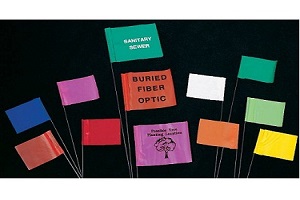Color Code for Utility Marking
Breaking ground for construction, farming, or any other reason requires ensuring you’re not damaging any existing infrastructure. Taking that extra step can prevent serious damage below ground that can sometimes be irreversible or unfixable. You are also putting yourself and others at risk without fully understanding the underground landscape and the implications of digging into it. The first step you must take before breaking ground is to call your local “One Call” shop where you can get all the information you need on the underground systems already in place.
Before beginning any excavation, it is required that the area is properly marked above ground. Those markings are usually in the form of small colored utility flags or posts, with paint, chalk, tape or even wax lines made between the markings. Generally, flags mark larger systems like multiple ducts or large pipes and posts mark smaller pipes and cables. Still, make sure to check your local code to ensure proper usage.
In an attempt to better educate the public, the government funded American Public Works Association (APWA) has shared a color code for utility markings on their website.
The color code reads as follows:
“WHITE – Proposed Excavation
PINK – Temporary Survey Markings
RED – Electric Power Lines, Cables, Conduit and Lighting Cables
YELLOW – Gas, Oil, Steam, Petroleum or Gaseous Materials
ORANGE – Communication, Alarm or Signal Lines, Cables or Conduit
BLUE – Potable Water
PURPLE – Reclaimed Water, Irrigation and Slurry Lines
GREEN – Sewers and Drain Lines”
Finally, correctly marking an area is as important as understanding the markings, and it never hurts to double check. If you do come across an unmarked structure, it is important to fully understand it before continuing your project. Take the extra time to reach out and use the resources at your disposal to ensure that you’ve covered every precaution.




